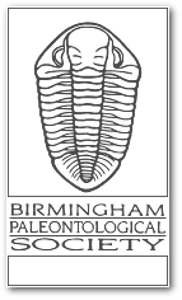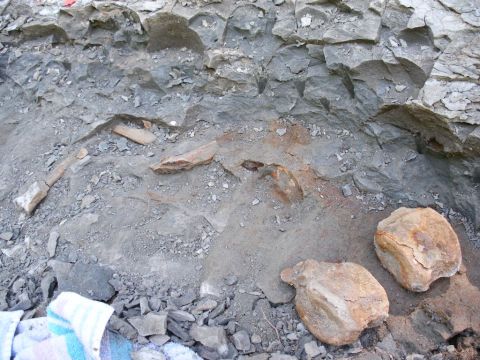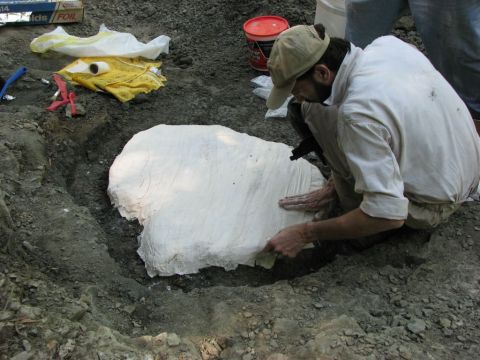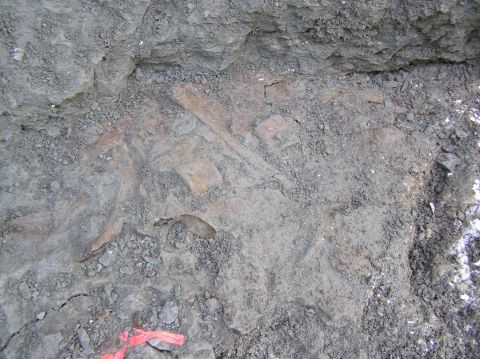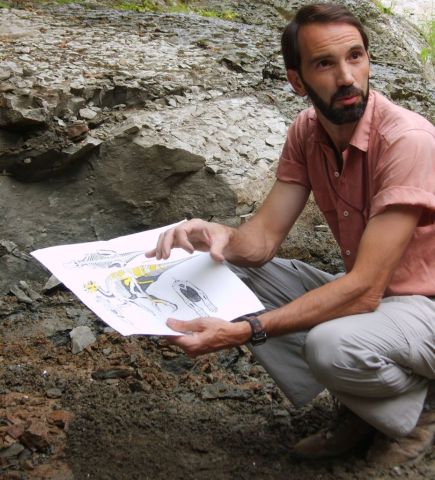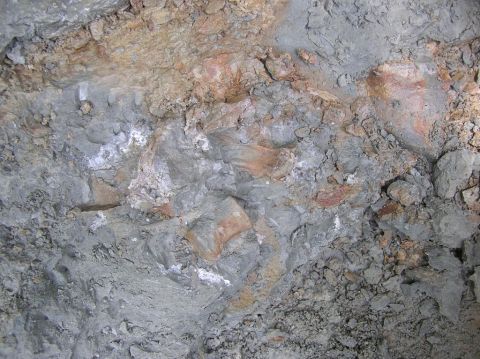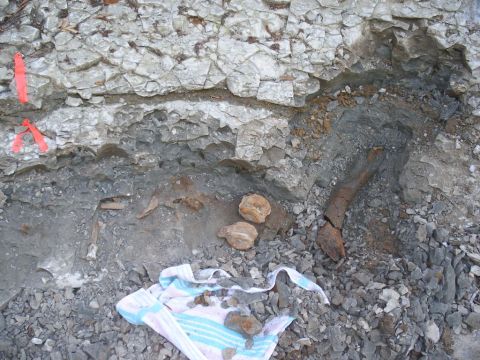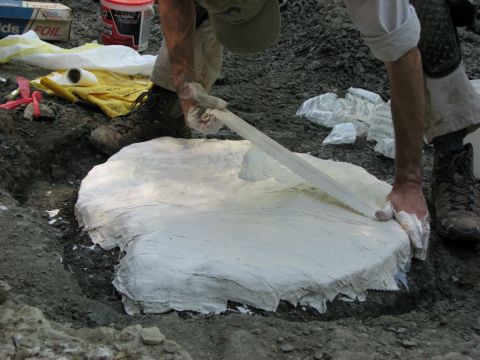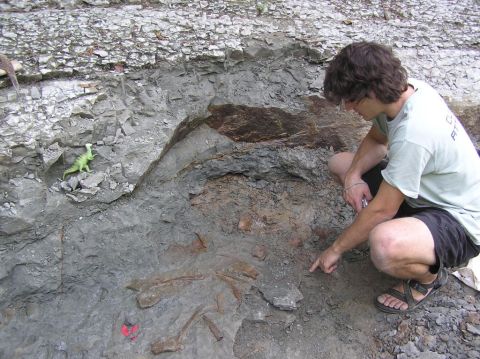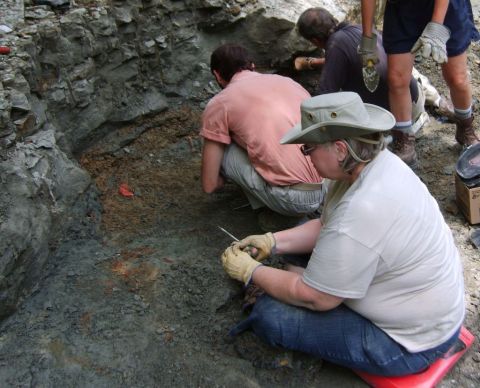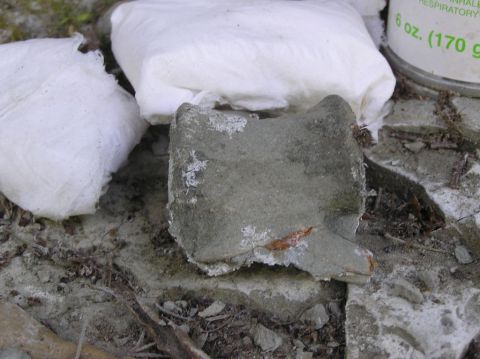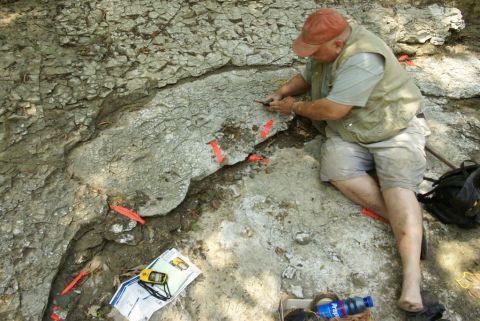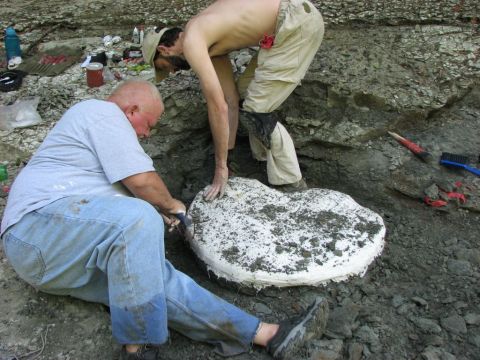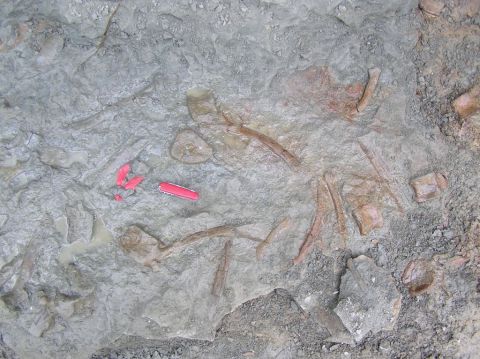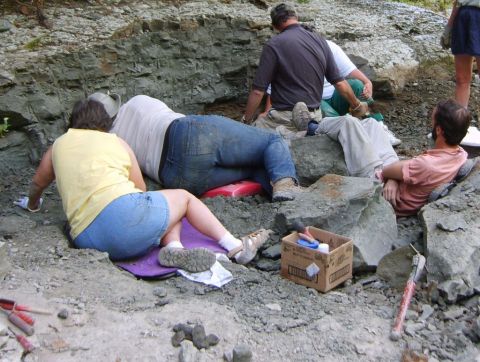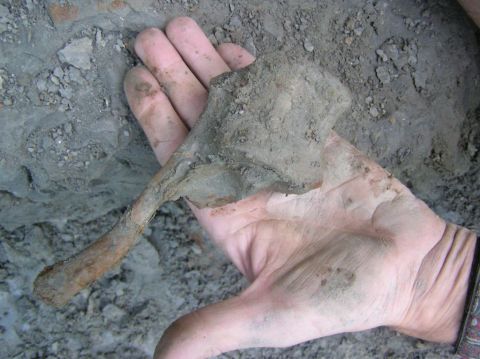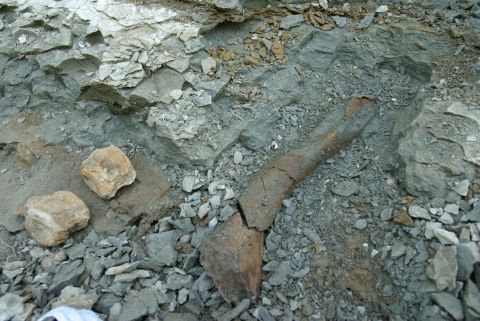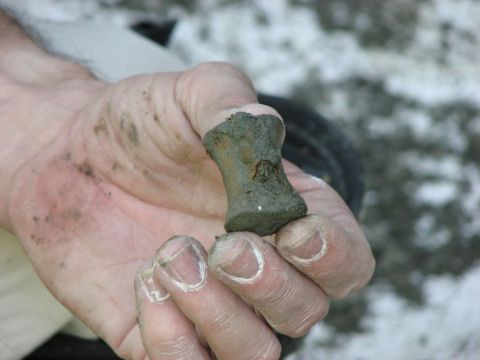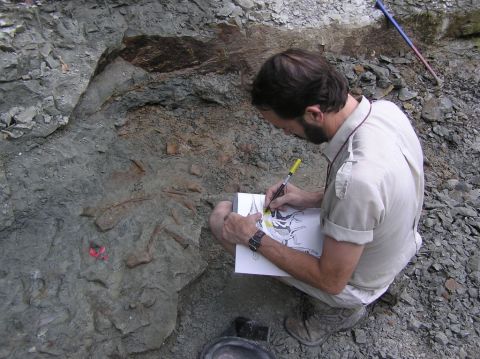BPS is excited that we can now share more information on the finding and excavation of a new species of dinosaur found by the Birmingham Paleontological Society on one of their monthly field trips several years ago. Dr. Jan Novak found the first of the bones, and called for more experienced members to come investigate. As Greg Mestler and others carefully dug around the bones, we realized these fossils were like no other that had been seen in our 30+ years of existence and exploring the wilds of Alabama. Our first thought was to contact James Lamb, one of the paleontologists who founded our organization, and has provided leadership and professional guidance throughout the years. At the time, James was the Curator of Paleontology at McWane Science Center. We asked him to come visit the site to make an identification. When he arrived, he recognized the fossil bones and teeth as a duck-billed dinosaur, and we made plans for James to lead the excavation, with members of BPS assisting at every step. On the first weekend, a complete skull was jacketed, and as the surrounding area was examined, more and more bone was found. Back at work after a very full weekend, James notified his employer, McWane Science Center, of the extent of the find, requested time to lead the dig, and immediately started negotiations with the landowner to conduct a full scale excavation.
Over the next three weeks, BPS members piled into James' vehicle about 7:00 am each morning and worked on the dig until darkness made it impossible to see, then made the long commute home. James and up to five BPS members at a time were on the site, carefully scraping away chalk and mud from the fragile fossils. Larger chunks of rock were removed by blunt force, ie., picks and shovels, to get down to the correct layer. Every scrap of debris was examined, where turtle bone, shark vertebra, and even Cretaceous seeds were found. The numerous vertebra and their processes were protected by wrapping in crimped aluminum foil, toilet paper, newspaper, and plastic bags. Each fossil was carefully labeled, and recorded in James' log book, often with diagrams to show the in situ orientation. Numerous photos were taken throughout the dig for documentation purposes.
The larger and more fragile fossils, including the skull and limb bones, were secured in plaster jackets, with strips of cloth cut from burlap, and cushioning provided by the prolific Spanish moss in the area. The larger jackets were hauled out using a sled built by James and a strong come-along. The largest jacket he had to manhandle himself, as no strong helpers were available that day, and McWane was unable to provide any staff (other than James) for the duration of the excavation. Even though McWane was unable to provide additional staff, they provided other valuable assistance to ensure the dig could continue.
During the excavation, James Lamb gave frequent mini-lectures to the BPS members on the dig site, describing the manner in which this terrestrial dinosaur could have ended up in a marine habitat, and the significance of our find. There was some speculation this might have been from a flood event, where numerous animals are washed out to sea, decompose, then sink to the bottom and are covered by mud and fossilized.
Members of BPS say this was the "experience of a lifetime", an exciting story to pass down to their kids and grandkids. Dr. Jan Novak named the duck-billed dinosaur "Big Greg", to honor one of our founding members, Greg Mestler, who unfortunately passed away in 2009. Greg's big dream was to find a dinosaur, and as ill as he was, he showed up many days ready to help with the excavation. Greg's guidance and leadership, paleontological expertise, extroverted and caring disposition, and excitement about finding fossils is sorely missed. He was a born teacher and loved life.
Once the dinosaur bones were safely housed at McWane Science Center, James Lamb was allotted one week to remove the skull bones from the matrix in the jacket, as there was an exhibit being built which took top priority. He knew the skull bones needed cleaned quickly, as the damp soil would have cracked the fragile bones if there was a delay. After his week was up, he continued the cleaning and prep work on his own personal time, a few days a week, for the next several months. In the meantime, James accepted a position as Curator of Paleontology for the Black Belt Museum, and Instructor of Zoology at the University of West Alabama. The dinosaur bones were on loan to UWA for a while, where he was allowed time to complete the remaining 90% of the cleaning and prep work. He worked steadily on the dinosaur, removing plaster jackets, cleaning the chalk off the hundreds of bones, stabilizing them, and carefully sorting the bones into separate boxes with identifying labels.
BPS was asked to keep this fantastic find private, until research was published, which was done. A while back, many years after the actual excavation, several researchers, Albert Prieto-Marquez, Gregory M. Erickson, and Jun A. Ebersole, decided to research the dinosaur fossils and discovered they represent a new species of dinosaur, which they named Eotrachodon orientalis, which means “dawn rough tooth from the east.” Their research was published January 2016 in the Journal of Vertebrate Paleontology, titled "A Primitive Hadrosaurid from Southeastern North America and the Origin and Early Evolution of 'Duck-billed' Dinosaurs".
Eotrachodon orientalis dinosaur vertebra and processes found and excavated by BPS members
James Lamb preparing the skull jacket for the Eotrachodon orientalis dinosaur
Eotrachodon orientalis dinosaur vertebra and processes.
James Lamb giving a lecture regarding what had been discovered thus far, and describing the environment where the dinosaur would have lived
Eotrachodon orientalis dinosaur bones, mostly vertebra.
Eotrachodon orientalis dinosaur vertebra, processes, and leg bone found and excavated by BPS members
James Lamb preparing the skull jacket for the Eotrachodon orientalis dinosaur
Rychard pointing to a newly exposed Eotrachodon orientalis dinosaur bone found in the next layer.
Martha, James and Bobby in the dig hole, examining their finds.
Dinosaur vert ready for wrapping, laying beside some fossils already wrapped.
James Lamb examining bone from Eotrachodon orientalis dinosaur
Greg excavating bone from Eotrachodon orientalis dinosaur
Greg and James knocking the skull jacket for the Eotrachodon orientalis dinosaur loose from the ground
Eotrachodon orientalis dinosaur bones found and excavated by BPS members
Several BPS members in the newly dug hole, while James takes a well deserved rest - he, Steve, and Bobby dug the hole with his pick, while BPS members shoveled the debris into a pile for later examination.
Eotrachodon orientalis dinosaur vertebra with the process still attached.
David and James excavating around the skull, in preparation for making a plaster jacket for protection.
Eotrachodon orientalis dinosaur vertebra and leg bone, the first bone found
- 1 of 5
- next ›
